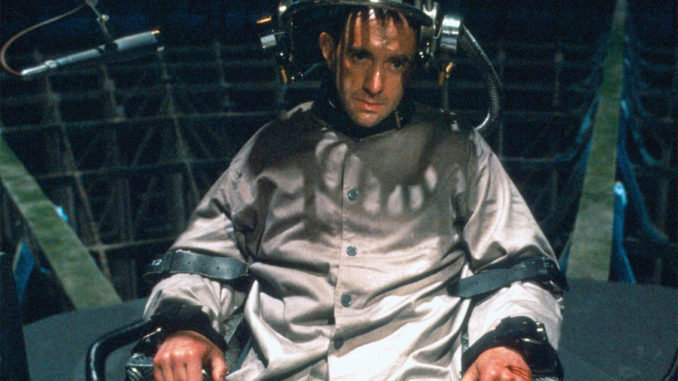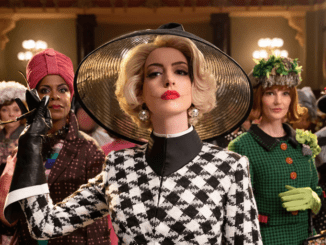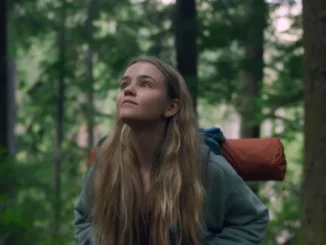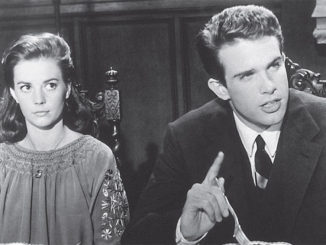
by Mark S. Andrew
Seldom has a film created such extreme reactions as Brazil. Hailed as a masterpiece by some, yet held in complete contempt by its own studio, the film stands as a shining example of visual poetry and the potential power of the edit to completely alter a film’s meaning.
At the time of Brazil’s initial release, the Reagan era was at its peak. Communism was waning and it appeared we had survived the ominous predictions of George Orwell’s 1984. But Monty Python animator-turned-director Terry Gilliam still saw an Orwellian future, though one of a more plausible nature: a government in total control, yet tremendously flawed, reflecting the cynicism of our own faith in the bureaucracy.
Trapped in this bureaucratic nightmare is Sam Lowry (Jonathan Pryce), a middle management dreamer surrounded by incompetent bosses and mountains of paperwork. But Lowry is plagued by dreams of freedom and the unknown woman who will lead him to escape from his humdrum life. When a typical government foul-up affords him a chance meeting with the girl of his dreams, he goes on a whirlwind journey in an attempt to win her heart and find the freedom he desperately seeks––a journey that ends with disastrous results.
Typical of all his films, Gilliam’s vision of the future is both amusing and frightening. Thanks to Norman Garwood’s award-winning production design, we see a bleak city, with technology that never works properly and miles of air and sewage ducts––all afterthoughts to the landscape of an ill-planned community. The real star of this film is the brilliant fantasy of Lowry’s vivid dream sequences.
I studied the various versions available of the film and became infatuated with the concept of how an edit could so greatly change the way a film was perceived… I remembered how the same footage in Brazil was used to portray extreme opposites of emotion, and realized I too could manipulate the footage
Picture Editor Julian Doyle makes the most of these stunning visuals in the final 20 minutes, creating a frenetic escape for Lowry from the government’s feared “Information Retrieval” branch, which uses torture to learn what they want to know. But in a shocking turn, we discover that this flight to freedom exists only in the protagonist’s mind. In truth, he has been lobotomized by IR’s extreme methods.
And thus, the stage was set for the behind-the-scenes drama of Universal Pictures vs. director Gilliam. The elaborate imagery, combined with the dark and decidedly “unhappy” ending, made the studio cringe at releasing the film that Gilliam intended. A bitter battle ensued that lasted months, with the filmmaker only winning the domestic release of his film after screening it subversively enough times that the praises of the press could not be ignored. But Universal managed the last laugh by giving an edited version (unauthorized by Gilliam) of the film a limited release, virtually no advertising and even less publicity. Despite all this, the film earned two Oscar nominations.
The final insult came when Universal released a syndicated TV version of the film, completely re-edited, in which Lowry actually does escape from his tormentors, and lives happily ever after in the countryside. Naturally, this version completely subverts Gilliam’s intent for the film, and vastly pales in comparison to the original. But the mere fact that such a version could be created is a testament to the power of editing. And that’s what makes the film so significant to me. (Gilliam’s 142-minute director’s cut was not released until it came out on Criterion Laserdisc in 1996.)
Typical of all his films, [Terry] Gilliam’s vision of the future is both amusing and frightening.
At the time of its theatrical release, I was still a newbie in Hollywood trying to find my way. Editing as a career was not even being considered; I was even green enough to think videotape was edited with a sync block and tape. The visual sense of Brazil left me awed––so much so that I leapt up in the theatre simply to see similar reactions from the rest of the audience. The storytelling pushed me in my personal writing to look toward darker imagery and less traditional Hollywood endings. But perhaps its greatest influence came later in my life, when I became an editor.
I studied the various versions available of the film and became infatuated with the concept of how an edit could so greatly change the way a film was perceived. As I began editing Reality TV, I remembered how the same footage in Brazil was used to portray extreme opposites of emotion, and realized I too could manipulate the footage shot in Reality to better reflect the story we needed to tell. At the same time, I also saw the importance of the integrity of the original vision––an importance I feel should exist in Reality TV.
Just as Universal re-edited Brazil to create a different and substantially inferior version, we can edit Reality footage to tell completely different stories. We should, however, strive to use our skills to tell the true story in the most compelling way possible.





